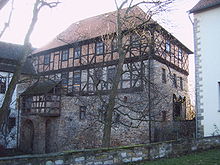Ummendorf Castle
| Ummendorf Castle | ||
|---|---|---|
|
Keep of Ummendorf Castle |
||
| Creation time : | 1178 | |
| Castle type : | Location | |
| Conservation status: | Keep, gatehouse | |
| Standing position : | Clericals, ministerials, nobles | |
| Place: | Ummendorf | |
| Geographical location | 52 ° 9 '18.5 " N , 11 ° 10' 57.6" E | |
|
|
||
The castle Ummendorf is a castle in Magdeburg in Saxony-Anhalt village Ummendorf .
history
The origins of the castle go back to the Archbishop of Magdeburg Friedrich I. von Wettin , who had a castle built here in 1178 to secure the border with today's Lower Saxony . Ministerials were responsible for the administration . In 1180 the Lords of Ummendorf were called Stiftsvasallen. In the middle of the 14th century the castle belonged to the knights Hildebrand and Volbrecht von Oebisfelde. On April 13, 1389, Archbishop Albert von Magdeburg acquired the castle and large parts of the village. The administration was incumbent on deployed captains. In the 15th century, the von Veltheim family received the castle as a fief. Under the rule of Ludolf von Veltheim , the castle became a base for robber barons . After raids on citizens of Magdeburg passing through , the castle was stormed by Magdeburg troops in 1430. The castle remained occupied by Magdeburgers until the atonement was established. From this medieval period the style is Romanesque built dungeon and located on the west side of the storehouse preserved.
In 1463 the castle fell to the von Meyendorff family, probably as a fief . Johann von Meyendorff then acquired the castle from the Archbishop of Magdeburg in 1535. The von Meyendorffs carried out extensive renovations between 1535 and 1581. The result is the irregular, three-winged complex , which is largely preserved today in the Renaissance style. Under Andreas von Meyendorff , the castle developed into the local center for the implementation of the Reformation . The castle remained in the family's possession until the von Meyendorff family died out in 1650, according to other sources in 1667.
During the Thirty Years War the castle complex was occupied and devastated by the Protestant Christian von Braunschweig in 1623 . 1625 was occupied by the Catholic imperial troops under Wallenstein . Colonel Pechmann had the valuable book collection in the castle transported to Bohemia in nine wagons . In 1644 there was a Königsmark regiment in the castle.
After the von Meyendorff family died out, the castle fell back to the ore monastery of Magdeburg. The facility was continued as an office and saddlery . During the period of French rule and the Kingdom of Westphalia at the beginning of the 19th century, the castle was given to the French Marshal Soult as a gift . After Napoleon's defeat , the complex was then managed as a Prussian state domain until it was purchased by the Ummendorf community in 1912. A museum was set up in the castle as early as 1924, from which today's Börde Museum emerged.
architecture
Particularly noteworthy is the donjon, which dates back to the time the castle was founded and has long been popularly known as the "prisoner's tower". The lower floors of this tower are dated to the second half of the 12th century. The upper part with the octagonal tower room dates from the 16th century. The tower, which is over 20 meters high, can be visited as part of the museum tour.
Todays use
In addition to the Börde Museum in the Börde district with its agricultural engineering exhibition and its herb garden comprising more than 400 different herbs and plants, there is a primary school in the south wing of the castle.
literature
- Bock: Local history of the Neuhaldensleben district. Neuhaldensleben 1920, commissioned by E. Zabel, page 120 f.
- Corinna Köhlert, Jürgen Blume: Of palaces and fortresses in Saxony-Anhalt. Halle (Saale) 2000, Mitteldeutscher Verlag, ISBN 3-89812-058-9 , page 145
Web links
Individual evidence
- ^ Köhlert, flower: Castles in Saxony-Anhalt. P. 145.
- ^ Bock: Local history of the district of Neuhaldensleben. P. 120.
- ^ Bock: Local history of the district of Neuhaldensleben. P. 120.
- ^ Köhlert, flower: Castles in Saxony-Anhalt. P. 145.
- ^ Bock: Local history of the district of Neuhaldensleben. P. 120.
- ^ Köhlert, flower: Castles in Saxony-Anhalt. P. 145.
- ^ Bock: Local history of the district of Neuhaldensleben. P. 121.



